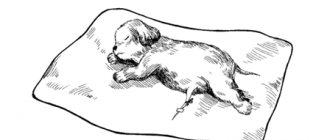Like all dogs, Pugs exhibit varying signs and symptoms throughout pregnancy. This process usually lasts about 63 days.
Gestation of puppies is divided into three stages: early, middle and last. Each lasts approximately 20 days and involves obvious changes in your dog's behavior.
Whether the mating was planned or the pregnancy was accidental, this article will teach you how to recognize the signs and symptoms and care for your pet.
Features of pug pregnancy
The first heat in animals of this breed occurs between 6-12 months, during which they can already become pregnant. Breeders carry out the first mating only after the animal is two years old. Breeding too early can cause complications for the dog and the litter.
There are several important features of pregnancy:
- The gestation period for this breed ranges from 57-65 calendar days. If the pregnancy lasts more than 67 days, you need to take your pet to the veterinarian.
- The average litter size is three to five puppies, but it can often be as little as one puppy or as many as seven or even nine. With the help of an ultrasound, a veterinarian can accurately determine how many offspring are expected.
- Dogs do not have the hCG hormone, so you won’t be able to check whether your pet is expecting a baby or not using a “human” pregnancy test. To do this, be sure to visit a veterinarian.
- Due to the fact that puppies are born with broad shoulders and large heads, birth can be complicated. You should contact your veterinarian early to determine whether your dog needs a C-section.
- The possibility of mating should not be allowed more than once a year. The animal needs time to recover physically and emotionally from the birth.
- A dog can also have a false pregnancy, which is diagnosed by a specialist.
Normal and false pregnancy. Features of pug behavior
It is impossible to find out how many puppies will be born in the early stages. A pug can have up to 7 puppies. If the litter is small (2 puppies), then the puppies are usually larger. But after birth they develop in the same way as puppies from many. In the case when there are 7 puppies, they are small, but quickly gain weight and height, and do not lag behind in development.
15 days after conception, try not to disturb the pregnant woman over trifles. It is important to pay attention to your diet. The one she had before is not suitable for her, she needs to choose food for pregnant pugs if she is on dry food, or introduce vitamins for pregnant women if she is on a natural diet.
Recommendations for pugs on a natural diet: Now is the time to diversify their diet with foods containing calcium. These include kefir and yogurt, cottage cheese. Also introduce eggs, cheese, fruits, and vegetables into your pregnant pug’s diet.
Walk your dog more, but it should not run fast, try to keep the walks calm. Walks are a must, because your pet needs fresh air.
If you live in an apartment, then you should carry your pet up the stairs in your arms. Bring in gently, supporting your chest and tummy with both hands. After a walk, the pug needs to eat and rest, and get a good night's sleep.
At week 5, the tummy usually becomes rounded, the skin tightens, the nipples turn pink, and discharge appears from them. The babies in the belly are already developed, just not covered with fur. The dog may experience nausea and will not be able to eat for several days - this is toxicosis. Hungry fainting is also not uncommon during this period of pregnancy; your task is to adjust your diet.
A false pregnancy can also occur, when a dog, after estrus and mating, feels like one. Hormones are raging, milk is secreted, such “imaginary” persons with an interesting position walk back and forth, not finding a place for themselves, trying to arrange a house for the puppies.
They may even find an imaginary puppy and feed it, do not allow this behavior. And be sure to do an ultrasound; if it turns out that this is all a bluff, the doctor will prescribe medications that will normalize the dog’s condition.
Pug temperature during birth
Before the birth process begins, the dog may begin to behave very restlessly - whining, licking itself frequently, trying to dig something out.
Often the pug becomes lethargic, loses its appetite and appears indifferent to everything that happens around it. All these signs indicate that it is time to give birth and you need to prepare everything necessary for this.
When a bitch whelps for the first time, her body temperature drops and is 37.5 degrees. After this temperature threshold is recorded, approximately 5-6 hours later the first contractions occur. This is the most appropriate moment to go to the clinic and call a specialist at home.
https://youtu.be/hekEzrq18SM
How long does it take for pugs to give birth?
The time of birth varies depending on the physiological characteristics of each bitch. On average, the time when the first puppy is born from the start of contractions is 10-15 minutes.
After this there may be a break and then the contractions begin again. Typically, the birth of offspring takes about 3 hours, but can take longer.
You should be prepared for the fact that the birth will be difficult and long due to the physiological characteristics of puppies, which have large heads and shoulders.
Signs of complications:
- Contractions do not begin within 24 hours after the temperature drops below 37 degrees.
- The first puppy was not born within three hours of the start of active labor.
- Subsequent puppies do not appear within two hours of active labor.
- The animal stopped pushing before the entire litter was born.
- The fetus does not move out of the birth canal for more than a few minutes, despite constant tension.
In all of the above cases, the pet needs to receive urgent veterinary care.
What to do if pregnancy lasts longer than average
There are many reasons for premature birth. It is important to correctly determine the cause, since the decision will depend on this - whether it is necessary to stop labor in the dog or give it the opportunity to give birth to premature offspring.
Causes of premature birth:
- intrauterine death of the litter, non-viable offspring;
- hidden pathologies (toxoplasmosis, herpes, brucellosis, staphylococcus);
- hormonal problems;
- intrauterine infection;
- stress, fear;
- jump from a height.
Stopping labor in the first four cases means risking losing your pet! If contractions began under the influence of stress, fright or a jump from a height, then you need to call your veterinarian and try to prevent tragic consequences.
We have already said that offspring born before the 57th day of pregnancy will not be able to survive. Such puppies die either immediately or 1-5 days after birth. What to do in other cases? If puppies are born 58-61 days from the start of pregnancy, then such offspring are called premature, but the puppies have every chance of survival. In such cases, it is important to immediately seek help from a veterinarian so that he can help deliver the baby and carry out procedures to open the lungs of newborns.
We invite you to read: Premature baby: care features
Periods and calendar of pregnancy by day
Pregnancy in pets proceeds much faster than in humans, so this breed shows the first signs early that a replenishment is expected soon.
Week 1
At the early stage there are usually no symptoms, only some individuals may experience slight nausea and loss of appetite by the end of the first week.
Weeks 2 and 3
The first changes may begin to appear:
- She may be more tired than usual.
- Her belly may appear slightly swollen.
- She may lick herself much more often than usual.
- The nipples become larger than before.
During the 2nd week you may still experience morning sickness causing nausea.
Week 4
The belly becomes rounded, clearly indicating that the bitch is expecting offspring. The nipples will enlarge even more as the body prepares for feeding. Your pet's appetite will improve significantly.
Weeks 5 and 6
The animal will get tired quickly, become less sociable, its behavior will change, and its weight will increase significantly. The bitch will prepare for the appearance of the litter - arrange her place.
Signs
It is quite difficult to determine early pregnancy by the appearance of the animal. During the first period of conception, the pet changes its behavior, may sleep longer, and refuse to go for walks.
But there are signs that clearly show that the dog is pregnant. They begin to appear only in the second half of its interesting position:
- The mammary glands begin to swell and turn pink.
- Calm behavior, frequent rest.
- Urination becomes less frequent.
- A small amount of mucus may be released from the loop; it is usually colorless.
- In the first half of pregnancy, the dog can be overtaken by toxicosis. If toxicosis has dragged on too long and has begun to cause anxiety to the dog, you can consult a veterinarian.
- “Gluing” the loop.
- Appetite appears starting from the second half of pregnancy. Before giving birth, the dog can gain another half of its weight.
- The belly will begin to grow about three weeks before delivery. If this is your pet’s first birth, then you shouldn’t expect a big belly. A dog can only produce a couple of puppies.
- A pet's poor appetite should be a cause for concern. It is worth seeking help from a specialist. This may be an individual characteristic of the pug or the presence of a disease.
Dogs can easily endure pregnancy and childbirth on their own. But given the nature of pugs, they are too attached to their owner, it is better to be nearby and provide constant support. It is impossible to miss the moment of childbirth; the dog’s behavior will tell you that a crucial moment is beginning.
Caring for a pregnant dog
Every day you need to provide special care for your pet. While pregnant, bitches should receive more healthy food than usual. The expectant mother's appetite will increase significantly around the 3rd or 4th week and everything she eats will be passed on to her babies in the womb.
Food - The goal is to increase the amount of nutrients while maintaining a healthy diet. There is no need to take additional vitamins and mineral supplements - this can cause health problems for both her and the fetus.
Activity - You can continue to walk your pet daily at a normal pace unless your vet places restrictions on exercise. Daily exercise will help her stay in shape, but a sedentary lifestyle can lead to weakened joints and muscles.
Comfort - provide the expectant mother with her own personal space. She will need a good bed that will provide her with a quality night's rest. Pugs love to be part of the family - this is a feature of this breed, so do not take it to a distant corner or another room.
What you need to give birth
As soon as the birth process begins, you should be with your pet to provide the necessary assistance. If this is your first home birth experience, it is better to go to a veterinary clinic and call a specialist at home.
Essentials:
- Warmer.
- Clean towels.
- Thermometer, Vaseline.
- Enema.
- Surgical sterile needle.
- Sterilized thread (to tie the umbilical cord or apply stitches).
- Disinfectant spray.
- Small dropper.
- Round scissors.
- Sterile scissors.
- Surgical gloves.
- Colored ribbons (to identify puppies).
- Saline solution.
- Pure water.
After each puppy is born, you will need to place them in a small basket with a warm heating pad at the bottom, covered with a soft blanket. Place the basket close enough to the mother so that she can see her newborn puppies and can rest after the birth.
Signs and diagnosis of labor
The female's gestation period lasts about two months. Since a bitch can give birth to anywhere from one to 9 puppies, it's best to be prepared and know the steps to help make the process easier:
Step 1
Feel your pet's abdominal area with your hands. With gentle pressure, you will be able to feel the shape of the puppies still in the womb.
Step 2
Note the time between contractions - the place of uterine contraction should be palpable during examination. If the gaps are too large or the contractions stop after a few hours, then these are most likely signs of false labor.
Step 3
After the attempts begin, no more than one hour should pass without the birth of a small puppy. Otherwise, this may mean that the baby is stuck in the birth canal and emergency help from a specialist is needed.
In fact, breeding dogs of this breed requires careful supervision by experienced doctors, since the birth of offspring often occurs with complications.
How long do they go?
After a successful mating with a male, offspring can be expected within 63-64 days. This is a healthy pregnancy, without abnormalities, which lasts about two months.
14 days after mating, you can undergo an examination by a veterinarian and find out exactly about the interesting situation of the dog. An ultrasound examination will give an accurate result, but it is better not to resort to it again.
By day/week
After mating, fertilization occurs only on the fourth day. During the first 48 hours, the sperm moves towards the fallopian tubes, where it connects with the egg.
7 days: After fertilization, the common cell (zygote) moves further and enters directly into the uterus. The dog shows no signs of pregnancy, its condition does not change externally. You don’t have to change your diet for now and walk your dog the same way as before.
13-14 days: the placenta forms in the uterus. A connection is formed between the embryo and the expectant mother. The dog's behavior remains the same. If this is your pet’s first pregnancy, then it is better to consult with specialists on all issues.
15 days: After two weeks of pregnancy, the embryo begins to form major organs.
16-17 days: in almost a day the embryo grows from 0.6 mm to one millimeter. In a couple of days, his head, central nervous system, and spine are formed.
Days 18-20: all internal organs are actively forming. It is not recommended to make changes to the pug's routine yet.
Day 21: At the end of the third week of pregnancy, the fetus develops a heart.
Day 22: starting from the fourth week, the dog’s diet changes and you need to monitor it more carefully. Toxicosis often appears at this time, so it is recommended to give food in small portions, but often.
Days 23-24: At this stage, the organs of vision, hearing and smell appear. You need to monitor the dog’s diet and not overuse vitamins A and D. Otherwise, this will lead to active growth of the fetus and, as a result, by the time of birth it will already be a large puppy, which can be a problem.
24-34 days: future puppies develop teeth, the spine becomes stronger and stronger. Limbs are forming.
Day 35: active growth of puppies leads to the fact that the pug’s belly begins to stand out. Now we can talk about external signs of pregnancy. The girl begins to behave less actively and feel more vulnerable.
Day 40: internal organs are fully formed.
Day 44: puppies already take up a lot of space in the uterus and can be felt with your hand if you put it on the pet’s belly. But it is still impossible to understand how many babies there will be. The dog's mammary glands swell and become brighter.
50-57 days: the embryos are well developed, their size reaches almost 15 centimeters. It is important to monitor the animal and provide it with peace. Premature birth can end sadly. Puppies at this stage are not yet able to survive when they are born.
Day 58: Colostrum is released from the mammary glands.
Day 59: From now on you can expect childbirth.
Day 63: In a healthy pregnancy, the dog stops eating one day before the onset of labor. Your water may break.
Day 64: labor begins. As a rule, they can already begin from day 57. Therefore, you need to carefully monitor the animal from the last week until birth.
Pregnancy lasts about two months.
Size of embryos on the 15th, 30th, 50th day
During the first and second weeks, the embryo attaches to the wall of the uterus. The placenta is formed and from this moment it begins to fully develop. The beginning of the third week of pregnancy is an important stage. It is at this time that developmental disruptions that occur are reflected in future puppies.
Fetal size at different stages of pregnancy:
- Day 15 – the embryo reaches a size of 1 mm.
- Day 30 – the fetus grows up to 2 cm.
- Day 50 – the shape of the fetus is almost formed and its size reaches 12 cm.
When do they start moving?
About a couple of weeks before the birth, you can feel the puppies moving in your dog's stomach. It is worth paying attention to some points; if the animal is not well-fed, then the babies can be felt earlier.
In a dog with a large weight, the puppies may move completely unnoticed, or if it is a young mother with two babies in the womb, then their movements may also not be felt.
Possible difficulties
After watching your pet go through all the stages of pregnancy, watching her give birth is the ultimate reward.
Most of the time her body does exactly what it's supposed to do and her puppies will come out without a problem.
However, sometimes the process does not go as nature intended. When a puppy becomes stuck in the birth canal, prompt action on your part can save the life of the puppy and the mother.
How to help? Before you intervene, make sure there is actually a problem and the animal needs help. A dog's labor usually lasts from three to 12 hours, and occurs in three stages. Puppies are born during the second stage and appear 20 minutes apart from each other.
Before you intervene, see how long the pushing lasts. The animal can rest for up to two hours between the birth of puppies. When each puppy is born, you need to check that it is breathing and help it if necessary.
False
A false pregnancy has all the signs and symptoms of a real one. It usually occurs if the fertilization process is not complete. The embryo did not conceive, but the body thinks otherwise. This is not a disease, just a special psychological state of the animal. It can arise out of nowhere, even if there was no mating with a male dog.
Timing of appearance and symptoms
Symptoms of false pregnancy that occur 4-9 weeks after estrus:
- Nervous and restless state.
- The dog begins to “nest.”
- Protecting imaginary puppies.
- Loss of interest in food, walks, toys, etc.
How long does it last?
After a couple of weeks, the animal comes to its senses on its own. With the help of the owner, you can get out of this state faster:
- Do not give dairy products that stimulate milk production.
- Reduce the amount of food you eat.
- Do not allow contact with small puppies.
- Distract yourself with walks and other physical activities.
- Remove all toys.
How to care for newborn puppies
Newborn puppies are born blind, deaf and toothless, but with a sucking instinct and the ability to crawl towards the warmth of their mother's body. However, sometimes mom and babies need a little help.
- Prepare a warm bed in advance in a box or basket where newborn babies will be. The box should be large enough for mother and puppies to move freely. If towels or blankets are used, they should be pulled tight to prevent puppies from becoming entangled in the folded fabric.
- Provide a heat source. Newborn puppies cannot maintain proper body temperature, so it is often necessary to place a heat lamp a safe distance above the box.
- A household thermometer placed at the back of the puppy crate can help you monitor the temperature, but observing the babies' body language can give you a clue as to whether they are feeling comfortable. Puppies tend to lie in contact with each other to share warmth, so if they are lying in a pile it may mean they are too cold, and if they are sleeping separately they may be too hot.
- Monitor the growth and condition of each puppy. Using a baby scale, weigh each puppy immediately after birth and record its weight. Weighing yourself daily will help prevent weight loss or litter deterioration.
The most important thing in this whole process is to remember that the mother dog knows what to do and how to do it instinctively. You simply monitor the process to make sure there are no complications and, if necessary, take emergency measures.
Be sure to give the new mother more time and let her rest between feedings.
How many days does it last?
Let's figure out how long the dog walks in this position. A normal pregnancy for a four-legged mother lasts from 58 to 62 days. During the initial stage of pregnancy (the first 2 weeks), you should not disturb the dog with examinations, so as not to harm the formation of the embryos.
In the next period from 15 to 40 days from the date of fertilization, it is worth showing your pet to a specialist in order to monitor the progress of pregnancy and identify the condition of future pugs.
The final step is preparation for childbirth and lactation starting from 50 days. At this time, it is necessary to help the woman in labor - to create a cozy nest. An excellent option is a box house with an insulated floor, an open top, and a small side at the entrance so that the puppies do not crawl away. Prepare a separate box or bowl with a blanket or flannel with film inside, equipped with a heating pad. The newborn puppies placed there will be kept warm while the dog gives birth to the rest.










